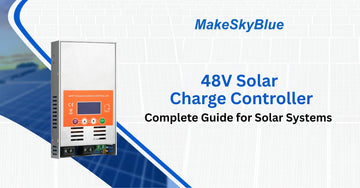One of the most significant components of a solar system is a 48v solar charge controller. It regulates electric flow between the solar panels and the batteries. This is a device that will prevent overcharging or destruction of the batteries. It ensures that your system operates well, no matter you have a small home setup or even a big system that is off-grid.
This guide will describe what a 48v solar charge controller is, how its various types operate and why MPPT is the most suitable to most users. We will also provide detailed tables to compare features and specifications.
What Is a Charge Controller?
A charge controller is a device placed between the solar panel and the battery. It ensures that the battery voltage stays within safe limits. Without a controller, a battery could overcharge or discharge too much, reducing its battery life. Key functions of a solar charge controller include:
-
Regulating charge current to protect batteries.
-
Preventing over-voltage and low voltage issues.
-
Providing safety features like over-current protection.
-
Supporting both 12v, 24v, 36v, and 48v solar systems.
Types of Solar Charge Controllers
There are two main types of solar charge controllers:
PWM Solar Charge Controller
A PWM solar charge controller uses pulse width modulation to regulate charging. It is cost-effective and simple, best for 12v and 24v systems. Efficiency is lower (70–80%), making it suitable for small setups.
MPPT Solar Charge Controller
An MPPT solar charge controller tracks the maximum power point of solar panels. It converts excess voltage into current, giving 95–99% efficiency. Ideal for 48v solar systems and larger battery banks.
Why Choose a 48V Solar Charge Controller?
A 48 volt controller is ideal for homes or businesses running bigger off-grid solar systems. It can handle more power compared to 12v or 24v options. Benefits include:
-
Better energy storage for large battery banks.
-
Reduced energy loss in long cable runs.
-
Works well with 100a solar charge needs.
-
Longer battery life thanks to stable charging.
Comparison Between PWM and MPPT Solar Charge Controllers
|
Feature |
PWM Solar Charge Controller |
MPPT Solar Charge Controller |
|
Efficiency |
70% – 80% |
95% – 99% |
|
Suitable Voltage Systems |
12v, 24v |
12v, 24v, 36v, 48v |
|
Best For |
Small setups, DIY solar |
Large setups, 48v systems |
|
Cost |
Low |
Higher but efficient |
|
Battery Life Support |
Average |
Excellent |
|
Works With High PV Voltage |
No |
Yes (up to 100v+) |
|
Popular Brand Options |
EG4, basic PWM models |
Victron, SmartSolar, EG4 |
How MPPT Solar Charge Controllers Work
MPPT solar charge controllers use advanced tracking efficiency. They detect the best maximum power point from the solar panel. Then, they adjust the voltage and current to charge the battery bank properly. For example, if a solar panel produces 70 volts, the MPPT controller can step down that voltage to 48v and increase the current. This makes the most use of the available solar energy.
Top 48V MPPT Solar Charge Controllers
|
Model |
Voltage Range |
Current (Amp) |
Battery Support |
Special Features |
|
Victron SmartSolar |
12v–48v |
100A |
Lithium & Lead-acid |
Bluetooth, advanced MPPT |
|
EG4 48V MPPT |
48v |
60A – 100A |
Lithium batteries |
LCD, reliable performance |
|
Renogy Rover 48V |
12v–48v |
60A |
Lithium & AGM |
Built-in protections, durable |
|
EPEVER 48V MPPT |
12v–48v |
40A – 100A |
Lithium & Gel |
Smart monitoring, high PV input |
|
OutBack FM60/80 |
48v |
60A – 80A |
Battery banks |
Off-grid system ready |
Sizing a 48V Solar Charge Controller
To size correctly, you need to calculate:
-
Solar Panel Wattage ÷ Battery Voltage = Required Amps.
Example: 2000W ÷ 48v = 41.6A. -
Add 25% safety margin.
Required = 52A. -
Choose a 60A MPPT solar charge controller.
This ensures your power system runs without overload.
Common Mistakes to Avoid
-
Using a pwm controller with large 48v systems.
-
Not checking battery voltage compatibility.
-
Ignoring input voltage from panels.
-
Skipping fuse and protection setup.
Conclusion
The 48v solar charge controller is an ideal option that one would use when operating a medium or large size solar system. It guards batteries, enhances efficiency as well as long battery life. Although PWM is less expensive, MPPT solar charge controller is more dependable in high-voltage systems.
T is good to invest in the right controller and you can avail better performance, increased battery bank life and reduced energy savings. Always compare models, check features and size it appropriately to your system.
FAQs
What does a 48v solar charge controller do?
It regulates power from solar panels to batteries. This prevents overcharge and extends battery life.
Which is better, PWM or MPPT for 48v systems?
MPPT is better for 48v systems as it provides higher efficiency. PWM works best only for small setups.
How many panels can I connect to a 48v charge controller?
The number depends on panel wattage and controller amp rating. Always calculate total watts before connection.
Can a 48v solar charge controller work with lithium batteries?
Yes, most modern MPPT controllers support lithium batteries. Check compatibility before buying.
What size charge controller do I need for 2000W at 48v?
2000W ÷ 48v = 41.6A, so a 60A controller is required. Always add a 25% safety margin.





